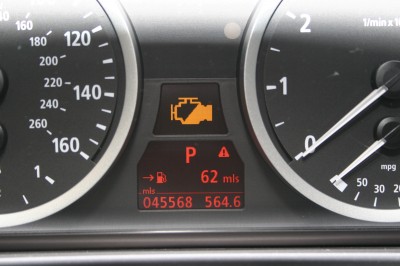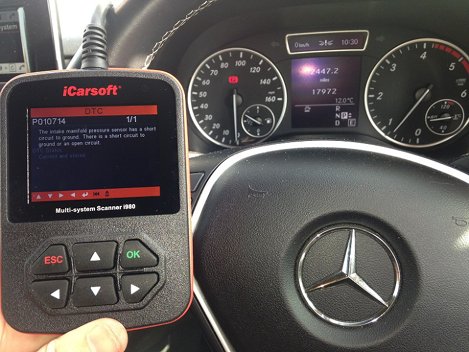Picture this: you are driving along when, out of the blue, your car’s transmission starts acting up. The “check engine” light comes on, telling you that there is a problem. At the same time, your car’s transmission automatically shifts into second or third gear and stays there.
What Transmission Do I Have?

Limited to one gear and 30-45 mph, you know there is a serious problem with your car’s transmission and you have to get your car to either your dealer or transmission repair shop to have the problem diagnosed and repaired.
Naturally, the first questions that go through your head are: Why did this happen? How severe is it? and How much will it cost to fix?
In This Guide
- What Causes Limp Mode?
- Limp Mode’s Protective Actions
- Example Situation
- How the Computer Determines That a Sensor is Incorrect
- What You Should Do
- Questions to Ask Yourself
What Causes Limp Mode?
Today, nearly every system in your vehicle is operated by the computer – including the transmission’s line pressure, shift timing, sequence and feel. The vehicle speed sensor provides input to help control ABS, fuel mixture, fuel injection and transmission operation. The manifold absolute pressure (MAP) sensor and throttle position sensor (TPS) provide the engine’s load information which is used to manage the shift and downshifting in the transmission when you’re driving up an incline or you’ve put the pedal to the metal.
Fail Code conditions or “Limp Mode” occurs when there is a problem with the logic of a vehicle’s computer. When the signal value sent by a sensor to the computer is not within a pre-programmed range specified by the manufacturer, it will switch to “secondary” programming. These procedures are designed to protect the transmission from further damage that could be caused by the signal error.
As long as the computer is receiving signals from the MAP, TPS, vehicle speed and other sensors that fall within their “normal” ranges based on the current conditions, the transmission will operate normally. However, as mentioned above, if it receives a signal that is outside of the expected range, it will switch to secondary/emergency operation.
The exact measures taken in secondary operation is determined by the computer’s logic as programmed by the manufacturer and depends on how far outside the acceptable range the signal is (if there is any signal at all). It might react differently when the value is higher than the highest parameter than it does when the value is lower than the lowest allowable value.
Limp Mode’s Protective Actions

If the signal value wasn’t far enough outside of the range to indicate a mechanical failure, the first thing the computer will do is turn the check engine light on to alert the driver that they should have the vehicle checked out using a code reader/diagnostic scanner to see if there are any “soft codes” listed. Soft codes can indicate that a low priority sensor has malfunctioned or is starting to break down. If the light goes away after restarting your car, it could mean that the sensor only failed once due to a loose connection or it could be a sign that its condition is getting worse. Critical functionality is typically unaffected by this kind of problem, but if the issue isn’t resolved, it can negatively impact the performance or fuel efficiency of the vehicle.
Now, if the signal value from a high priority sensor (necessary for critical functions) is dangerously far out of the acceptable operating range, the computer switches over to secondary “survival” mode. This is known as a “hard code”. In this mode, the computer shuts off the electronic shift solenoids. This disables the transmission’s ability to shift gears and causes it to default to single usable gear – usually second or third. In addition, the pressure in the transmission’s fluid lines is set to high in order to protect the bands and clutches from being damaged. The signals that control the line pressure are set to “full on” to prevent the clutch pack from a slipping dangerously.
All of these changes result in the previously described “Limp Mode”. Instead of leaving you stranded with a broken down vehicle, it enables the vehicle to limp home or to the nearest service center for repairs while reducing the risk of doing further damage.
Example
For example, one of situations that would cause a transmission to go into limp mode is if the cable harness going to the transmission is damaged or detached. In this case, the computer would sense that it lost communication with the transmission, but since the harness is detached, the command to go into limp mode cannot make it to the transmission. However, with no power supplied to the solenoids, the line pressure is set to high and the transmission is stuck in 2nd or 3rd gear – the same effect the limp mode command would have.
How the Computer Determines That a Sensor is Incorrect
Say, for example, that the computer receives a signal from the Throttle Position Sensor (TPS) stating that the pedal is to the metal when the throttle is actually closed. It would spot this error when it compared this status with the vehicle speed sensor, which would be signaling low or no speed. As soon as it sees this discrepancy, the computer will command the transmission to go into limp mode and turn the check engine light on. A signal value by itself can’t always be classified as an error, but when analyzed with other sensor outputs, the computer can easily figure out if there is a problem.

The fault code of the sensor causing the error is recorded by the computer. A mechanic can use a diagnostic scanner or code reader to find the recorded codes and then look them up in a table from the manufacturer to determine which sensor, and therefore which system is the source of the malfunction. Many scanners are pre-programmed with these tables and return more information than just the codes.
For example, the diagnostic scanner could return the code “35”, which indicates that the problem has to do with the transmission fluid temperature sensor. The abnormal values that were recorded and the “normal” range for the sensor could also be provided to the mechanic.
It is recommended to have a vehicle’s computer scanned regularly for fault codes – especially if the check engine light is on. This is done by most service centers during routine tune-ups.
What You Should Do
If your transmission is in limp mode, your transmission has a problem and you should get it fixed as soon as possible. Here is what you should do:
- Do not panic! Limp mode is specifically designed to limit further damage and allow you to get your car to a service center
- If possible, drive directly to a service center
- Otherwise, drive home and call a service center to have your vehicle towed
- If you do not feel comfortable driving at a limited speed, pull off the road where it is safe to do so and call for a tow
- It is advised that you do not continue to drive a vehicle in limp mode as it is unsafe and can cause further damage to your vehicle
Questions to Ask Yourself
Once your vehicle is safely in the service area, it is time to answer a few questions that will help diagnose the problem:
What Transmission Do I Have?

- How fast were you driving and how long had you been driving when the problem occurred?
- Did any lights on the dash come on? Did they come on when you started the car or after driving a while? Did they stay on?
- What repairs or maintenance has been done to the vehicle in the last month?
- Have you noticed any signs of a problem recently (noises, behaviors, leaks, etc.)?
More Information by Transmission Type
Problems by Make & Model
OBD2 Transmission Trouble Codes
| DTC Code |
|---|
| P0218 |
| P0702 |
| P0705 |
| P0730 |
| P0740 |

03 GMC Yukon . Changed out transmission. Now when engine gets warm. It goes into limp mode
Recently changed ignition in 98 jeep Cherokee now drive doesn’t work but first and second does
It’s in limp mode 2000 Chrysler lhs and gear selector indicator says in all gears have replaced input output sensors as well as tcm
Transmission appear to go into limp mode. However no check engine light no codes
Goes in limp mode
showing your tits should help with me getting out of limp mode…
I’ll replace the battery in alternator a few months ago the battery light is stayed on ever since and now it’s having transmission problems get somebody please tell me what my problem could be
I have a 2005 Mercury Mariner replace the battery and the alternator a few months ago battery light has stayed on and now having transmission problems could someone please enlighten me on what’s going on
You have to reprogram your transmission back to your system. I have an 2005 f250, I had to put key in ignition, turn it on, but not crank it, put the truck in neutral wait 2 seconds put it in drive wait 2 seconds and do that 5 times, put it in park, turn off, then back on and crank. It was fixed.
fucking karen